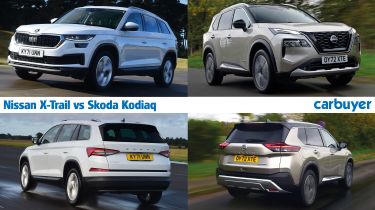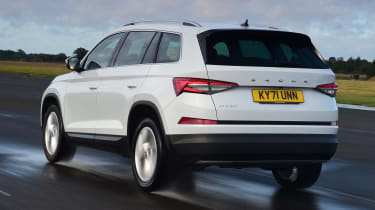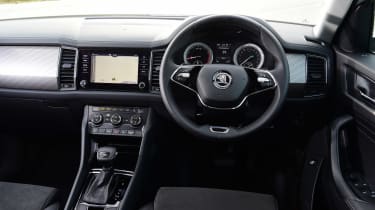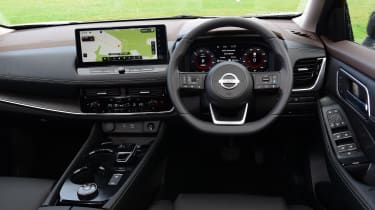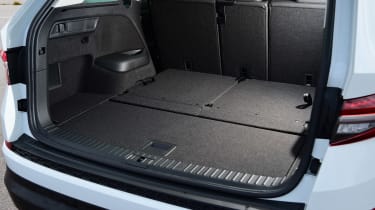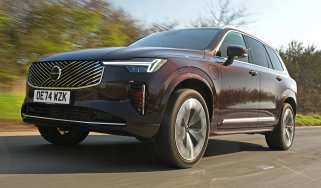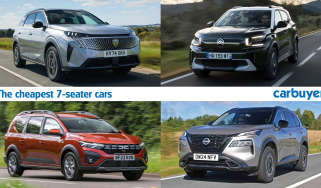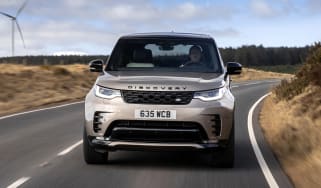Nissan X-Trail vs Skoda Kodiaq – which should you buy?
Looking for a practical seven-seat SUV? We compare two of the most popular choices
Buying a seven-seater is, on paper, incredibly simple; there are several van-based MPVs such as the electric Peugeot e-Rifter that offer plenty of space, while the Dacia Jogger can transport seven people for less than £20,000.
However, the majority of buyers desire more luxuries and style than either of these options offer, but can’t quite stretch to the likes of the Land Rover Discovery which starts from almost £60,000.
 The 10 best large SUVs on sale in 2025
The 10 best large SUVs on sale in 2025
Thankfully, several manufacturers offer seven-seat versions of their mainstream family SUVs; these are usually slightly larger than their five-seat counterparts and although slightly more expensive, are typically within the realms of affordability for many households.
Two of the most popular choices in this segment are the Skoda Kodiaq and the recently renewed Nissan X-Trail. While they couldn’t be more different in terms of approach to the seven-seat family SUV formula, both cars offer all the style and space growing families could ever need.
We’ve driven each SUV separately and in this article, we’ll compare our findings to help you decide which you should buy. If you wish to learn more about either car – or any new car for that matter – we have in-depth reviews elsewhere on our website. We also have lists of the best large SUVs and best seven-seaters, if you’d like to see what other options are out there.
For now, read on to see which is our favourite: the Nissan X-Trail or Skoda Kodiaq.
Which is the cheapest to run?
Given they are often invariably used every day, a seven-seat family SUV must be economical to run. While both the Nissan X-Trail and Skoda Kodiaq shouldn’t break the bank to drive daily, both cars achieve their low MPG figures in entirely different ways.
The Nissan X-Trail utilises the Japanese brand’s e-Power hybrid system, which is also found in the five-seat Nissan Qashqai. Rather than using an electric motor to assist the petrol engine, the X-Trail’s petrol engine is instead used to directly charge a battery pack, which in turn powers the electric motor. While this seems like it should make the car much more efficient, it’s less effective than you might think in this big, heavy SUV. Nissan states the X-Trail will return 48.6mpg on the combined WLTP test cycle; this is still more efficient than a standard petrol engine, however, a diesel or plug-in hybrid car will inevitably return better fuel economy figures. Of course, there’s also the mild-hybrid model, which is less expensive to buy, though it will return around eight less MPG than the e-Power hybrid. Still, if you have a low annual mileage this could be the one to pick.
On the other hand, the Skoda doesn’t get any form of hybrid assistance at all, instead relying on small, yet efficient petrol and diesel engines. While this means the Kodiaq will be of little interest to company car drivers due to its high Benefit-in-Kind tax rating, its lineup of fuel-sipping engines means the Skoda is both cheap to buy and run for private customers. Models using one of the 2.0-litre diesel engines are said to return over 50mpg, whereas even the entry-level 1.5-litre petrol will do around 40mpg, thanks to cylinder deactivation which can temporarily turn off part of the engine when it isn’t needed.
Which is the best to drive?
We don’t want to lie and tell you either of these SUVs drive like a sports car, nor do they come close to a performance SUV such as the Porsche Macan in terms of handling. However, both cars can be more fun behind the wheel than you might initially suspect.
With the top-of-the-range e-Power hybrid system and four-wheel-drive fitted, the Nissan X-Trail produces a healthy 210bhp (201bhp with front-wheel-drive). This means it gets from 0-62mph in around 7.5 seconds, however, it feels faster thanks to the mountain of torque from the electric motor. While there isn’t a huge amount of feel through the steering, there’s plenty of grip and body lean is kept well in check. The mild-hybrid engine is a bit of a let down though; with just 163bhp at its disposal, it feels rather underpowered for this size of car and is best reserved for city driving.
The Skoda Kodiaq is even more fun to drive, with accurate steering and tight body control on a twisty road. To make the most of the car’s well-tuned chassis, we recommend steering clear of the entry-level petrol and diesels and opting for one of the more powerful 2.0-litre units.
Sitting at the pinnacle of the range is the Kodiaq vRS model which utilises a 2.0-litre four-cylinder turbocharged petrol engine, similar to the one used in the Volkswagen Golf GTI. This produces 242bhp and gets the Kodiaq from 0-62mph in just 6.6 seconds, thanks to all-wheel-drive traction. However, while adaptive dampers and a bodykit do make the vRS feel slightly more sporty than the standard Kodiaq, it still can’t quite offer the same thrills as our favourite hot SUV, the Cupra Formentor – although, that isn’t offered with seven seats. Ultimately, the vRS is rather thirsty for a family car and feels more like a trim level than a true performance car, so we’d stick with the SE L Executive trim.
Which has the nicest interior?
Given you’ll be sitting for ages in traffic during the school run or cruising on the motorway for long periods on family trips, a seven-seat SUV must offer a comfortable and pleasant interior.
The Kodiaq’s cabin is exactly what you’d expect from a Skoda: well-built, and functional, but not exactly exciting. Unlike most modern cars that bury several functions within the touchscreen, the Skoda Kodiaq has plenty of physical buttons that are easy to operate when on the move. Speaking of the Kodiaq’s infotainment system, the central touchscreen measures eight inches diagonally (entry-level cars get a seven-inch screen) and is bolstered by a highly-configurable digital instrument cluster.
The X-Trail’s cabin feels like a giant leap forward from the car it replaces; bar a few bits of trim, everything you touch feels exceptionally high quality and sturdy, plus the overall design is slightly more interesting than the Skoda’s. The X-Trail’s optional 10-inch head-up display is one of the largest in the business, while the 12.3-inch touchscreen is incredibly responsive to your inputs.
One caveat, however, is that the entry-level Visia model doesn’t even come with a touchscreen at all. This trim level only includes an old-fashioned radio, which is practically unheard of in a new car nowadays and makes it almost essential to step up to a higher specification.
Which is the most practical?
Being seven-seat family SUVs, both of these cars are incredibly versatile and practical, so should be able to cover the majority of families' needs. Although either is available with three rows of seats, it’s important to remember that the third row is primarily designed for children; while adults can fit back there, they’ll find it relatively uncomfortable on longer journeys. However, if you must carry adults in the rear, the Kodiaq is your best bet.
With all seven seats in place, the Nissan X-Trail offers 177 litres of cargo space – about the same as a city car like the Volkswagen Up! and enough for a handful of shopping bags. The Kodiaq improves on this with 270 litres – more than you’d find in a MINI – but you’ll need to fold the third row down in both cars if you wish to carry anything larger.
Speaking of which, with two rows in place, the Kodiaq and X-Trail provide 735 litres and 485 litres of space respectively, and 2,005 and 1,424 litres with both sets of rear seats folded.
Which should you buy?
No matter which of these cars you choose, both are great practical family runarounds. However, there’s a reason why the Skoda Kodiaq is our Best Large Family Car award for 2023; it offers more space than the X-Trail, all while remaining cheaper to buy and more fun to drive. Therefore, the Skoda would be our pick.
Looking for a practical electric car? Check out our list of the top 10 best electric SUVs
Recommended
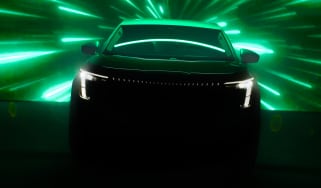
New giant Skoda EV coming next year to challenge the Kia EV9
Most Popular

Suzuki’s new 10-year warranty is free – here’s how to get it
Tips & advice

Car dashboard warning lights: what does each symbol mean?

Electric car charging stations: public networks, charger types, apps and maps


